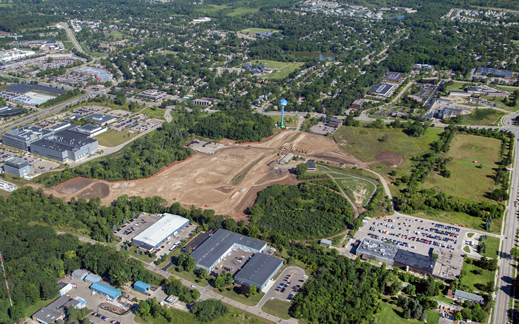Town Built for Driverless Cars
A mocked-up set of busy streets in Ann Arbor, Michigan, will provide the sternest test yet for self-driving cars. Complex intersections, confusing lane markings, and busy construction crews will be used to gauge the aptitude of the latest automotive sensors and driving algorithms; mechanical pedestrians will even leap into the road from between parked cars so researchers can see if they trip up onboard safety systems.

The urban setting will be used to create situations that automated driving systems have struggled with, such as subtle driver-pedestrian interactions, unusual road surfaces, tunnels, and tree canopies, which can confuse sensors and obscure GPS signals.
“If you go out on the public streets you come up against rare events that are very challenging for sensors,” says Peter Sweatman, director of the University of Michigan’s Mobility Transformation Center, which is overseeing the project. “Having identified challenging scenarios, we need to re-create them in a highly repeatable way. We don’t want to be just driving around the public roads.”
Google and others have been driving automated cars around public roads for several years, albeit with a human ready to take the wheel if necessary. Most automated vehicles use accurate digital maps and satellite positioning, together with a suite of different sensors, to navigate safely.
Highway driving, which is less complex than city driving, has proved easy enough for self-driving cars, but busy downtown streets—where cars and pedestrians jockey for space and behave in confusing and surprising ways—are more problematic.
“I think it’s a great idea,” says John Leonard, a professor at MIT who led the development of a self-driving vehicle for a challenge run by DARPA in 2007. “It is important for us to try to collect statistically meaningful data about the performance of self-driving cars. Repeated operations—even in a small-scale environment—can yield valuable data sets for testing and evaluating new algorithms.”
The simulation is being built on the edge of the University of Michigan’s campus with funding from the Michigan Department of Transportation and 13 companies involved with developing automated driving technology. It is scheduled to open next spring. It will consist of four miles of roads with 13 different intersections.
Even Google, which has an ambitious vision of vehicle automation, acknowledges that urban driving is a significant challenge. Speaking at an event in California this July, Chris Urmson, who leads the company’s self-driving car project, said several common urban situations remain thorny (see “Urban Jungle a Tough Challenge for Google’s Autonomous Car”). Speaking with MIT Technology Review last month, Urmson gave further details about as-yet-unsolved scenarios (see “Hidden Obstacles for Google’s Self-Driving Cars”).
Such challenges notwithstanding, the first automated cars will go into production shortly. General Motors announced last month that a 2017 Cadillac will be the first car to offer entirely automated driving on highways. It’s not yet clear how the system will work—for example, how it will ensure that the driver isn’t too distracted to take the wheel in an emergency, or under what road conditions it might refuse to take the wheel—but in some situations, the car’s Super Cruise system will take care of steering, braking, and accelerating.
Another technology to be tested in the simulated town is vehicle-to-vehicle communications. The University of Michigan recently concluded a government-funded study in Ann Arbor involving thousands of vehicles equipped with transmitters that broadcast position, direction of travel, speed, and other information to other vehicles and to city infrastructure. The trial showed that vehicle-to-vehicle and vehicle-to-infrastructure communications could prevent many common accidents by providing advanced warning of a possible collision.
“One of the interesting things, from our point of view, is what extra value you get by combining” automation and car-to-car communications, Sweatman says. “What happens when you put the two together—how much faster can you deploy it?”
Keep Reading
Most Popular
Large language models can do jaw-dropping things. But nobody knows exactly why.
And that's a problem. Figuring it out is one of the biggest scientific puzzles of our time and a crucial step towards controlling more powerful future models.
How scientists traced a mysterious covid case back to six toilets
When wastewater surveillance turns into a hunt for a single infected individual, the ethics get tricky.
The problem with plug-in hybrids? Their drivers.
Plug-in hybrids are often sold as a transition to EVs, but new data from Europe shows we’re still underestimating the emissions they produce.
Stay connected
Get the latest updates from
MIT Technology Review
Discover special offers, top stories, upcoming events, and more.